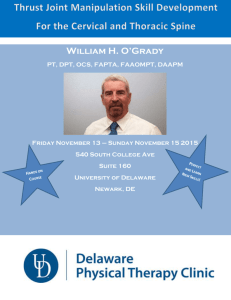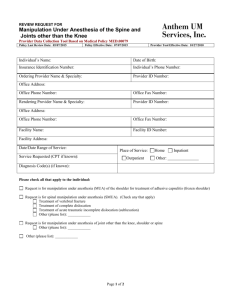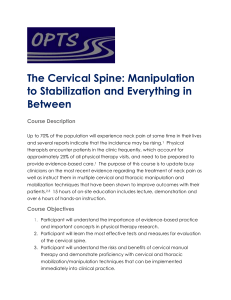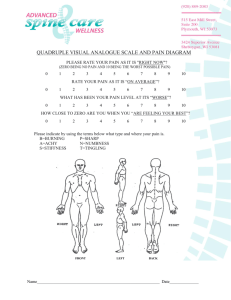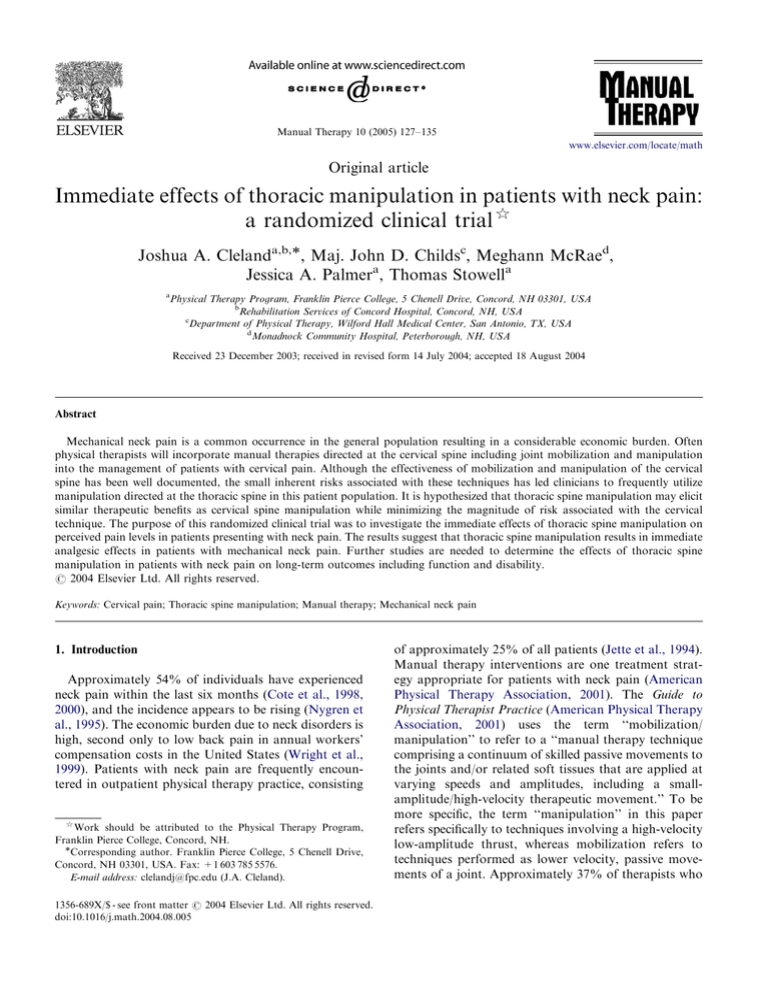
ARTICLE IN PRESS
Manual Therapy 10 (2005) 127–135
www.elsevier.com/locate/math
Original article
Immediate effects of thoracic manipulation in patients with neck pain:
a randomized clinical trial$
Joshua A. Clelanda,b,, Maj. John D. Childsc, Meghann McRaed,
Jessica A. Palmera, Thomas Stowella
a
Physical Therapy Program, Franklin Pierce College, 5 Chenell Drive, Concord, NH 03301, USA
b
Rehabilitation Services of Concord Hospital, Concord, NH, USA
c
Department of Physical Therapy, Wilford Hall Medical Center, San Antonio, TX, USA
d
Monadnock Community Hospital, Peterborough, NH, USA
Received 23 December 2003; received in revised form 14 July 2004; accepted 18 August 2004
Abstract
Mechanical neck pain is a common occurrence in the general population resulting in a considerable economic burden. Often
physical therapists will incorporate manual therapies directed at the cervical spine including joint mobilization and manipulation
into the management of patients with cervical pain. Although the effectiveness of mobilization and manipulation of the cervical
spine has been well documented, the small inherent risks associated with these techniques has led clinicians to frequently utilize
manipulation directed at the thoracic spine in this patient population. It is hypothesized that thoracic spine manipulation may elicit
similar therapeutic benefits as cervical spine manipulation while minimizing the magnitude of risk associated with the cervical
technique. The purpose of this randomized clinical trial was to investigate the immediate effects of thoracic spine manipulation on
perceived pain levels in patients presenting with neck pain. The results suggest that thoracic spine manipulation results in immediate
analgesic effects in patients with mechanical neck pain. Further studies are needed to determine the effects of thoracic spine
manipulation in patients with neck pain on long-term outcomes including function and disability.
r 2004 Elsevier Ltd. All rights reserved.
Keywords: Cervical pain; Thoracic spine manipulation; Manual therapy; Mechanical neck pain
1. Introduction
Approximately 54% of individuals have experienced
neck pain within the last six months (Cote et al., 1998,
2000), and the incidence appears to be rising (Nygren et
al., 1995). The economic burden due to neck disorders is
high, second only to low back pain in annual workers’
compensation costs in the United States (Wright et al.,
1999). Patients with neck pain are frequently encountered in outpatient physical therapy practice, consisting
$
Work should be attributed to the Physical Therapy Program,
Franklin Pierce College, Concord, NH.
Corresponding author. Franklin Pierce College, 5 Chenell Drive,
Concord, NH 03301, USA. Fax: +1 603 785 5576.
E-mail address: clelandj@fpc.edu (J.A. Cleland).
1356-689X/$ - see front matter r 2004 Elsevier Ltd. All rights reserved.
doi:10.1016/j.math.2004.08.005
of approximately 25% of all patients (Jette et al., 1994).
Manual therapy interventions are one treatment strategy appropriate for patients with neck pain (American
Physical Therapy Association, 2001). The Guide to
Physical Therapist Practice (American Physical Therapy
Association, 2001) uses the term ‘‘mobilization/
manipulation’’ to refer to a ‘‘manual therapy technique
comprising a continuum of skilled passive movements to
the joints and/or related soft tissues that are applied at
varying speeds and amplitudes, including a smallamplitude/high-velocity therapeutic movement.’’ To be
more specific, the term ‘‘manipulation’’ in this paper
refers specifically to techniques involving a high-velocity
low-amplitude thrust, whereas mobilization refers to
techniques performed as lower velocity, passive movements of a joint. Approximately 37% of therapists who
ARTICLE IN PRESS
128
J.A. Cleland et al. / Manual Therapy 10 (2005) 127–135
routinely perform manual therapy interventions for
patients with spinal disorders in their clinical practice
perform manipulation and/or mobilization to the
cervical spine in patients with neck pain (Hurley et al.,
2002). The effectiveness of these interventions in patients
with neck pain and cervicogenic headaches has been
recently supported by an increasing number of high
quality randomized clinical trials (RCT) (Bronfort et al.,
2001b; Evans et al., 2002; Hoving et al., 2002; Jull et al.,
2002), and systematic reviews (Bronfort et al., 2001a;
Gross et al., 2002) suggesting both forms of manual
therapy are effective.
The benefits of manual therapy interventions directed
to the cervical spine must be considered in the context of
the potential risks. The risk of serious complications
such as vertebrobaslilar insufficiency (VBI) has been
estimated to be extremely low (approximately six in 10
million; 0.00006%) (Hurwitz et al., 1996). However,
studies to date have largely failed to substantiate the
ability of currently available screening procedures
to identify at-risk patients prior to treatment (DiFabio,
1999). Therefore, it has been suggested that cervical
manipulation interventions be abandoned altogether
(Bolton et al., 1989; Cote et al., 1996; DiFabio,
1999; Haldeman et al., 1999, 2002a,b). In one survey
of physical therapists in Canada, 88% of respondents
strongly agreed that all available screening tests should
be performed prior to cervical manipulation (Hurley
et al., 2002), suggesting that therapists are indeed
concerned about the risks. Therefore, some therapists
may conclude the benefits achieved from manual
therapy interventions directed to the cervical spine are
not worth even the small risks associated with these
interventions.
Clinical experts have suggested that a thorough
examination of the thoracic spine be included in the
evaluation of patients with primary complaints of neck
pain (Porterfield and DeRosa, 1995; Greenman, 1996).
Due to the biomechanical relationship between the
cervical and thoracic spine, perhaps disturbances in joint
mobility in the thoracic spine serve as an underlying
contributor to the development of neck disorders. It has
also been demonstrated that mobilization/manipulation
of joints remote to the patient’s pain results in an
immediate hypoalgesic effect (Vicenzino et al., 1996,
1998, 2001; Paungmali et al., 2003). This is speculated to
occur through the stimulation of descending inhibitory
mechanisms (Vicenzino et al., 1998; Skyba et al., 2003).
For these reasons it has been suggested that perhaps the
incorporation of thoracic spine manipulation interventions in lieu of manipulation or mobilization interventions directed to the cervical spine may avoid even the
small inherent risks associated with manual therapy
interventions directed to the cervical spine, while
achieving similar therapeutic benefits (Erhard and Piva,
2000).
Only scant evidence exists regarding the use of
thoracic spine manipulation in patients with neck pain.
Flynn and colleagues have reported preliminary data
suggesting that thoracic spine manipulation results in an
immediate reduction in pain and increases in cervical
range of motion in individuals presenting with primary
neck dysfunction (Flynn et al., 2004). However, the lack
of a comparison group in this study precludes establishing that a cause-and-effect relationship exists. In
addition, Parkin-Smith (Parkin-Smith and Penter,
1998) and colleagues demonstrated that thoracic manipulation in addition to cervical manipulation in patients
with neck pain was no more advantageous than cervical
manipulation alone. Therefore, the purpose of this study
was to further investigate the immediate effects of
thoracic manipulation on neck pain in a randomized
clinical trial.
2. Methods
Potential participants were patients between 18 and
60 years of age with a primary complaint of mechanical
neck pain referred by their primary care physician to an
outpatient orthopaedic physical therapy clinic. Mechanical neck pain was defined as nonspecific pain in the area
of the cervicothoracic junction that is exacerbated by
neck movements (Bogduk, 1984; Childs et al., 2003).
The study was approved by the Institutional Review
Board at Franklin Pierce College (Rindge, NH) before
recruitment and data collection began. All patients
provided informed consent.
Patients with ‘‘red flags’’ for a serious spinal condition
(e.g., infection, tumors, osteoporosis, spinal fracture,
etc.) were excluded, as were individuals who were
pregnant, exhibited positive neurologic signs or symptoms suggestive of nerve root involvement (eg., symptoms distal to the acromion, or diminished upper
extremity reflexes, sensation, or strength), had a history
of cervical or thoracic surgery, exhibited hypermobility
of the thoracic spine, or those who had prior experience
with spinal manipulative techniques.
Prior to randomization, patients completed several
self-report measures and then received a standardized
history and physical examination by a licensed physical
therapist. Demographic information including age,
gender, past medical history, location and nature of
symptoms was collected. Self-report measures included
a body diagram to assess the distribution of symptoms
(Mann et al., 1993). Subjects also completed the Neck
Disability Index (NDI) to measure perceived disability.
The NDI was collected only at baseline to assess for
differences in disability between groups. The NDI is
scored from 0 to 50, with higher scores corresponding to
greater disability. The score is then multiplied by two
and expressed as a percentage. The NDI has been
ARTICLE IN PRESS
J.A. Cleland et al. / Manual Therapy 10 (2005) 127–135
demonstrated to be a reliable and valid assessment of
disability in patients with neck pain (Vernon and Mior,
1991). A Visual Analog Scale (VAS) was used to record
the patient’s level of resting pain at baseline and
immediately after treatment. The VAS is a 100 mm line
anchored with a ‘‘0’’ at one end representing ‘‘no pain’’
and ‘‘100’’ at the other end representing ‘‘the worst pain
imaginable’’. Patients placed a mark along the line
corresponding to the intensity of their symptoms, which
was scored to the nearest millimeter. The VAS is a
reliable and valid instrument to assess pain intensity
(Price et al., 1983; Bijur et al., 2001) and was selected as
the outcome measure based on its ability to detect
immediate changes in pain (Bijur et al., 2001; Bird and
Dickson, 2001; Gallagher et al., 2001).
Following the baseline examination, the examining
therapist left the treatment room and notified a second
licensed physical therapist blinded to the patient’s
demographic information and baseline levels of pain
and disability that the subject was ready for thoracic
spine segmental mobility examination and associated
treatment based on group assignment. Segmental
mobility testing was performed in the positions of
thoracic spine flexion and extension according to the
procedures described by Bookhout (1994). The specific
level(s) and position of restriction was recorded. The
intrarater reliability of accurately identifying the specific
level of segmental mobility restriction in the thoracic
spine is poor (Kappa=.33) (Christensen et al., 2002).
Following the segmental mobility examination, patients were randomly assigned to receive either thoracic
spine manipulation or placebo manipulation. A computer-generated randomized table of numbers created
prior to the beginning of the study was utilized to
determine group assignment. The patient’s group assignment was sealed in a sequentially numbered opaque
envelope and was opened after the treating therapist
129
completed the segmental mobility examination. Treatment was then administered according to the patient’s
group assignment. The treating therapist was therefore
unaware of the patient’s group assignment during the
segmental mobility examination.
2.1. Manipulation group
Patients randomized to the manipulation group
received thoracic manipulation interventions directed
to the previously identified segmental mobility restrictions. To perform the manipulation, the stabilizing hand
was placed at the level immediately caudal to the
restricted segment using a ‘‘pistol grip’’ (Fig. 1). Once
the premanipulative position was achieved the patient
was instructed to take a deep inhalation and exhale.
During the exhalation the treating clinician performed a
high velocity, small amplitude thrust in a direction to
facilitate relative closing or opening of the respective
facet joint as indicated by the segmental examination
(Fig. 2) (Flynn, 1994). If an audible cavitation was heard
during the first manipulation attempt, the treating
clinician proceeded to the next segment. If no audible
cavitation was heard, the patient was repositioned, and
the manipulation intervention was repeated at the same
segment. If no audible cavitation was noted after two
attempts, the physical therapist manipulated the next
segmental restriction. This procedure was repeated for
each segmental mobility restriction identified, progressing sequentially from cephalad to caudad. The level at
which treatment was directed and whether an audible
cavitation was achieved was recorded.
There is little evidence to suggest that the thoracic
spine manipulation interventions used in this study are
specific for an individual level (Isaacs and Bookhout,
2002). Even presuming they are, it is possible that the
lack of reliability to accurately identify individual
Fig. 1. Hand positioning utilized during manipulation techniques (actual technique performed with skin to skin contact).
ARTICLE IN PRESS
J.A. Cleland et al. / Manual Therapy 10 (2005) 127–135
130
Fig. 2. Manipulation technique for a flexion restriction. High velocity, small amplitude thrust performed in the direction of the arrow.
segmental motion restrictions (Christensen et al., 2002),
means that the segment presumed to be restricted may
not be the same segment at which the thoracic spine
manipulation intervention was directed. However, this
procedure is consistent with standard of care practice
during thoracic spine manipulation in patients with neck
pain at our facility, and we are unaware of another
decision-making scheme preferable to this one.
2.2. Placebo manipulation group
Patients randomized to receive placebo thoracic spine
manipulation were placed in the identical set up position
as patients in the manipulation group with the exception
of hand positioning. An ‘‘open hand’’ was placed over
the inferior vertebrae of the pre-determined segmental
restriction. Once the ‘‘premanipulative position’’ was
achieved, the patient was instructed to take a deep
inhalation and then exhale. No high-velocity thrust
maneuver was performed during the exhalation. The
level at which the placebo or manipulation intervention
was directed and whether an audible cavitation was
achieved were both recorded. Given that patients with
previous exposure to spinal manipulation were excluded
from the study, it is unlikely that patients were aware
that a high-velocity thrust maneuver is usually performed during this manipulation intervention.
The therapist who performed the baseline examination then re-entered the room, remaining blinded to the
patient’s group assignment. The patient was asked to
report their perceived level of pain intensity on the VAS
after treatment. This assessment was always performed
within 5 min after completing treatment. All subjects
were instructed to contact the principal investigator if
they experienced any side effect (soreness lasting greater
than 3 h).
2.3. Data analysis
Baseline demographic and self-report measures of
pain and disability were compared between groups using
independent t-tests or Mann–Whitney U tests for
continuous data, and w2 tests of independence for
categorical data (Table 1). A two-way repeated measures analysis of variance (ANOVA) was used to assess
the change in pain intensity immediately after treatment.
Intervention (thoracic spine manipulation or placebo
manipulation) served as the between-subjects independent variable and Time (baseline and immediately after
treatment) served as the repeated measures factor. The
hypothesis of interest was the two-way InterventionTime interaction based on an a priori determined
alpha-level equal to .05. We hypothesized that patients
who received thoracic spine manipulation would experience greater immediate improvements in pain than
patients who received placebo manipulation. All data
analysis was performed using the SPSS Version 10.1
statistical software package (SPSS Inc, Chicago, IL).
3. Results
Sixty-eight patients were screened for eligibility
during a six-month period from January 2003 to June
2003. Sixteen patients (24%) did not satisfy the inclusion
and exclusion criteria for the study. Sixteen eligible
patients (31%) elected not to participate because of
preferring not to receive manipulation interventions
(n=11) or specifically requesting manipulation (n=5).
The remaining 36 patients, mean age equal to 36
(SD=9.8) (27 female), were randomized to receive
thoracic spine manipulation (n=19) or placebo manipulation (n=17) (Fig. 3).
ARTICLE IN PRESS
J.A. Cleland et al. / Manual Therapy 10 (2005) 127–135
131
Table 1
The results of statistical analysis between manipulation and placebo manipulation groups for demographics and pretreatment visual analog score
data
Age mean (SD);
Gender mean (SD);
Symptom Duration (in weeks) mean (SD);
VAS pretreatment mean (SD);
VAS post treatment means (SD);
VAS change score mean (SD);
Number of manipulations or placebo manipulations mean (SD);
NDI mean (SD)
Manipulation group
(n=19)
Placebo manipulation group
(n=17)
P
36 (8.5)
14 females
12.2 (3.5)
41.6 (17.8)
26.1 (17.2)
15.5 (7.7)
3.7 (.83)
28.4 (11.9)
35 (11.3)
13 females
13.2 (4.2)
47.7 (18.4)
43.5 (19.5)
4.2 (4.6)
3.0 (.89)
33.6 (14.2)
.742
.849
.460
.323
o.01
o.001
.291
.237
VAS=Visual analog scale.
NDI=Neck disability index.
68 patients referred to physical therapy
with a diagnosis of cervical pain
52 eligible
16 ineligible:
7- fell outside age range for inclusion
5- presented with radicular symptoms
2- pregnant females
1- prior history of cervical surgery
1- history of thoracic fracture
16 refused to participate:
11- preferred not to receive
manipulation
5- specifically requested
manipulation
36 randomized
19 received thoracic
manipulation
17 received placebo
manipulation
Fig. 3. Flow chart depicting subject selection and randomization.
No differences in key demographic variables or
baseline levels of pain and disability were detected
between the groups at baseline (P4.05) (Table 1). The
repeated measures ANOVA demonstrated a significant
InterventionTime interaction (Po.001) (Fig. 4), suggesting that patients receiving thoracic spine manipulation experienced immediate improvements in pain
compared to patients in the placebo group. The change
in pain in the group receiving thoracic spine manipulation was 15.5 mm (SD 7.7) mm (95% CI: 11.8, 19.2),
compared to a change in the group receiving placebo
manipulation of 4.2 mm (SD 4.6) (95% CI: 1.9, 6.6).
The number of thoracic spine manipulations and
placebo manipulations in each group was 3.7 and 3.0,
ARTICLE IN PRESS
J.A. Cleland et al. / Manual Therapy 10 (2005) 127–135
132
Intercept Graph for VAS Scores of *Intervention*
Time (P< 0.001)
50
47.7
VAS Score
45
40
43.7
41.6
35
30
25
Manipulation
Placebo
25.6
20
Pretest
Posttest
Fig. 4. Intercept graph for visual analog scores of *Intervention* Time
(Po.001).
respectively (P=.29). No subjects in either group
contacted the principal investigator after the completion
of the study to report any side effects. Considering this
we expect that no one experienced any sensation more
than mild soreness following treatment or placebo.
4. Discussion
The results of this study suggest that thoracic spine
manipulation in patients with a primary complaint of
neck pain results in immediate improvements in their
neck pain. Patients receiving thoracic spine manipulation demonstrated a mean change of 15.5 mm (95% CI:
11.8–19.2) on the VAS, compared to only a 4.2 mm
(95% CI: 1.9–6.6) change among patients in the placebo
group. Even if one presumes the lower bound of the
95% CI of 11.8 to be the point estimate for patients
receiving thoracic spine manipulation, this magnitude of
change still represents a clinically meaningful level of
improvement (Kelly, 1998; Bird and Dickson, 2001;
Kelly, 2001; Gallagher et al., 2001). In contrast, even if
one conservatively presumes the upper bound of the
95% CI of 6.6 to be the point estimate for patients in the
placebo group, this magnitude of change falls below the
necessary level of change to substantiate that a clinically
meaningful change has occurred (Kelly, 1998; Bird and
Dickson, 2001; Kelly, 2001; Gallagher et al., 2001).
Despite evidence for its effectiveness, considerable
attention has been given to the risk of serious
complications such as vertebrobasilar insufficiency
(VBI) from manual therapy interventions directed to
the cervical spine (Hurwitz et al., 1996; DiFabio, 1999;
Haldeman et al., 1999, 2002a,b). However, recent
evidence suggests that cervical spine manipulation is
beneficial for some patients (Cassidy et al., 1992;
Hurwitz, 1996; Nilsson et al., 1997). Moreover, using
techniques that place the patient’s neck in a more
neutral position (i.e. avoiding the terminal range of
extension and rotation) appears to be a prudent strategy
to minimize these risks and may be a more important
consideration than the amount of force used (Mann and
Refshauge, 2001; Symons et al., 2002). Therefore, we are
not suggesting that cervical spine manipulation be
avoided. However, the results of this study suggest that
thoracic spine manipulation may be a reasonable
alternative, or perhaps supplement to manual therapy
interventions directed to the cervical spine. ParkinSmith and Penter (1998) demonstrated that manipulating both the cervical and upper thoracic spine did not
result in any significant benefits over patients receiving
cervical manipulation, for neck pain. However, it was
reported that some of the patients also received soft
tissue massage yet the number of individuals or their
group assignment was not reported. Therefore it is
unknown if this added variable could have affected
patient outcomes.
Despite the limited evidence for thoracic spine
manipulation, many clinicians have intuitively adopted
this same practice presumably because of less concern
about risks with thoracic spine manipulation (Adams
and Sim, 1998). A recent survey among clinicians that
practice manual therapy reported that the thoracic spine
is the region of the spine most often manipulated,
despite the fact that more patients complain of neck
pain (Adams and Sim 1998).
The precise mechanism by which thoracic spine
manipulation improves neck pain remains elusive. It
has been suggested that reductions in neck pain from
thoracic spine manipulation interventions may be
attributable to a restoration of more normal biomechanics to this region, potentially lowering mechanical
stresses and improving the distribution of joint forces in
the cervical spine. The theory that a biomechanical link
between the thoracic and cervical spine may lead to
abnormal distribution of forces in the cervical spine has
only recently been investigated. Norlander et al. (1996,
1997), Norlander and Nordgren (1998) investigated
whether mobility in the cervico-thoracic motion segment
is associated with musculoskeletal neck-shoulder pain.
They reported a significant relationship between decreased mobility in the thoracic spine and the presence
of subjective complaints associated with neck pain
(Norlander et al. 1996, 1997; Norlander and Nordgren,
1998). This hypothesis would have been further supported if we had collected measures related to musculoskeletal impairments such as cervical range of motion.
Several recent studies (Vicenzino et al., 1996, 2001;
McLean et al., 2002; Coppieters et al., 2003) have
demonstrated that manual therapy interventions directed at the spine can result in improvements in pain in
regions distant to the area in which the treatment is
directed. In addition, recent studies (Chiradejnant et al.,
2003; Haas et al., 2003) have demonstrated that
ARTICLE IN PRESS
J.A. Cleland et al. / Manual Therapy 10 (2005) 127–135
mobilization/manipulation techniques directed at impaired motion segments were no more beneficial than
the treatment of randomly selected segments. It has been
speculated that the immediate hypoalgesia following
manual techniques directed at the spine may be related
to stimulation of descending inhibitory mechanisms.
(Vicenzino et al., 1998; Skyba et al., 2003).
We acknowledge several limitations. First, we limited
this study to a short-term follow-up based on this study
serving as a preliminary step in the investigation of the
effects of thoracic spine manipulation in patients with
neck pain. However, the fact that statistically significant
and clinically meaningful change occurred over such a
short time frame among patients who received thoracic
spine manipulation bolsters the argument that these
changes are likely relevant for patients with neck pain,
providing impetus for future research in this area.
Additionally, examining changes in cervical range of
motion could have provided further insight as to the
biomechanical implications associated with thoracic
spine manipulation in patients with neck pain. Although
we did not measure cervical spine ROM in this study,
preliminary evidence (Flynn et al., 2004) suggests that
thoracic spine manipulation is associated with immediate improvements in cervical spine ROM, providing a
theoretical construct by which thoracic spine manipulation may act to improve pain in patients with a primary
neck complaint.
Future research in this area should examine the longterm effects of thoracic spine manipulation in patients
with neck pain on outcomes of care, patient satisfaction,
and costs. Head-to-head clinical trials are also needed to
determine if thoracic spine manipulation is most
beneficial in isolation, or if it should in some combination as a supplement to manual therapy interventions
directed to the cervical spine. Given the recent development and validation of a clinical prediction rule to
identify patients with low back pain likely to experience
a successful outcome from spinal manipulation (Flynn
et al., 2002), perhaps the development of a clinical
prediction rule would be advantageous to identify
whether a subgroup of patients with a primary
complaint of neck pain exists that may benefit from a
manual therapy treatment approach directed primarily
to the thoracic spine.
5. Conclusion
Thoracic spine manipulation results in immediate
improvements in perceived levels of cervical pain in
patients with mechanical neck pain. Given the concern
regarding the risks of cervical spine manipulation,
perhaps thoracic spine manipulation is a reasonable
alternative, or supplement to, cervical manipulation and
mobilization to maximize the patient’s outcome at a
133
reasonably low level of risk. This study was limited to an
immediate follow-up and the patient’s perceived levels
of pain, thus further research is needed to examine the
longer-term effects of thoracic spine manipulation on
patient-centered outcomes and determine if relevant
subgroups of patients with neck pain exist who may
particularly benefit from thoracic spine manipulation
interventions.
Disclaimer
The opinions or assertions contained herein are the
private views of the authors and are not to be construed
as official or as reflecting the views of the U.S. Air Force
or Department of Defense.
References
Adams G, Sim J. A survey of UK manual therapists’ practice of and
attitudes towards manipulation and its complications. Physiotherapy Research International 1998;3(3):206–27.
American Physical Therapy Association (APTA). Guide to physical
therapist practice, 2nd ed. Alexandria, VA: APTA; 2001.
Bijur PE, Silver W, Gallagher JE. Reliability of the visual analog scale
for measurement of acute pain. Academic Emergency Medicine
2001;8(12):1153–7.
Bird SB, Dickson EW. Clinically significant changes in pain along the
visual analog scale. Annals of Emergency Medicine
2001;36(6):639–43.
Bogduk N. Neck pain. Australian Family Physician 1984;13:26–30.
Bolton PS, Stick PE, Lord RS. Failure of clinical tests to predict
cerebral ischemia before neck manipulation. Journal of Manipulative and Physiological Therapeutics 1989;12(4):304–7.
Bookhout MR. Evaluation of the Thoracic Spine and Rib Cage. In:
Flynn TW, editor. The thoracic spine and rib cage; musculoskeletal
evaluation and treatment. Boston: Butterworth-Heinemann; 1994.
p. 147–70 (chapter 8).
Bronfort G, Assendelft WJ, Evans R, Haas M, Bouter L. Efficacy of
spinal manipulation for chronic headache: a systematic review.
Journal of Manipulative and Physiological Therapeutics
2001a;24(7):457–66.
Bronfort G, Evans R, Nelson B, Aker PD, Goldsmith CH, Vernon H.
A randomized clinical trail of exercise and spinal manipulation for
patients with chronic neck pain. Spine 2001b;26(7):788–99.
Cassidy JD, Lopes AA, Yong-Hing K. The immediate effect of
manipulation versus mobilization on pain and range of motion in
the cervical spine: a randomized controlled trial. Journal of
Manipulative and Physiological Therapeutics 1992;15(9):570–5.
Childs JD, Whitman JM, Fritz JM, Piva SR, Young B. Physical
therapy of the cervical spine and temporomandibular joint.
Lacrosse, WI: Orthopaedic Section, American Physical Therapy
Association, Inc; 2003.
Chiradejnant A, Maher CG, Latimer J, Stepkovitch N. Efficacy of
‘‘therapist selected’’ versus ‘‘randomly selected’’ mobilization
techniques for the treatment of low back pain: a randomized
controlled trial. Australian Journal of Physiotherapy
2003;49:233–41.
Christensen HW, Vach W, Vach K, Manniche C, Haghfelt T,
Hartvisger L, Hoilund-Carlsen PF. Palpation of the upper thoracic
spine: an observer reliability study. Journal of Manipulative and
Physiological Therapeutics 2002;25(5):285–92.
ARTICLE IN PRESS
134
J.A. Cleland et al. / Manual Therapy 10 (2005) 127–135
Coppieters MW, Stappaerts KH, Wouters LL, Janssens K. The
immediate effects of a cervical lateral glide treatment technique in
patients with neurogenic cervicobrachial pain. Journal of
Orthopaedic and Sports Physical Therapy 2003;33(7):369–78.
Cote P, Kreitz BG, Cassidy JD, Thiel H. The validity of the extensionrotation test as a clinical screening procedure before neck
manipulation: a secondary analysis. Journal of Manipulative and
Physiological Therapeutics 1996;19(3):159–64.
Cote P, Cassidy JD, Carroll L. The Saskatchewan Health and Back
Pain Survey: the prevalence of neck pain and related disability in
Saskatchewan. Spine 1998;23(15):689–98.
Cote P, Cassidy JD, Carroll L. The factors associated with neck pain
and its related disability in the Saskatchewan population. Spine
2000;25(9):1109–17.
DiFabio RP. Manipulation of the cervical spine: risks and benefits.
Physical Therapy 1999;79(1):50–65.
Erhard RE, Piva SR. Manipulation therapy. In: Placzek JD, Boyce
DA, editors. Orthopaedic physical therapy secrets. Philadelphia:
Hanley and Belfus; 2000. p. 83–91.
Evans R, Bronfort G, Nelson B, Goldsmith CH. Two-year follow-up
of a randomized clinical trial of spinal manipulation and two types
of exercise for patients with chronic neck pain. Spine
2002;27(21):2383–9.
Flynn TW. Direct treatment techniques for the thoracic spine and rib
cage: muscle energy, mobilization, high-velocity thrust, and
combined techniques. In: Flynn TW, editor. The thoracic spine
and rib cage; musculoskeletal evaluation and treatment. Boston:
Butterworth-Heinemann; 1994. p. 171–210 (chapter 9).
Flynn T, Fritz JM, Whitman J, Wainner R, Magel J, Butler B, Garber
M, Allison S. A clinical prediction rule for classifying patients with
low back pain who demonstrate short-term improvement with
spinal manipulation. Spine 2002;27(24):2835–43.
Flynn T, Wainner R, Whitman J, Childs JD. The immediate effect of
thoracic spine manipulation on cervical range of motion and pain
in patients with a primary complaint of neck pain—a technical
note. Journal of Orthopaedic and Sports Physical Therapy, 2004, in
Review.
Gallagher EJ, Liebman M, Bijur PE. Prospective validation of
clinically important changes in pain severity measured on a
visual analog sale. Annals of Emergency Medicine 2001;38(6):
633–8.
Greenman PE. Principles of Manual Medicine, 2nd ed. Philadelphia,
PA: Lippincott Williams & Wilkins; 1996.
Gross AR, Kay TM, Kennedy C, Gasner D, Hurley L, Yardley K,
Hendry L, McLaughlin L. Clinical practice guidelines on the use of
manipulation or mobilization in the treatment of adults with
mechanical neck disorders. Manual Therapy 2002;7(4):193–205.
Haldeman S, Kohlbeck FJ, McGregor M. Risk factors and
precipitating neck movements causing vertebrobasilar artery
dissection after cervical trauma and spinal manipulation. Spine
1999;24(8):785–94.
Haldeman S, Kohlbeck FJ, McGregor M. Stroke, cerebral artery
dissection, and cervical spine manipulation therapy. Journal of
Neurology 2002a;249(8):1098–104.
Haldeman S, Kohlbeck FJ, McGregor M. Unpredictability of
cerebrovascular ischemia associated with cervical spine manipulation therapy: a review of sixty-four cases after cervical spine
manipulation. Spine 2002b;27(1):49–55.
Haas M, Groupp E, Panzner D, Partna L, Lumsden S. Efficacy of
cervical endplay assessment as an indicator for spinal manipulation. Spine 2003;28(11):1091–6.
Hoving JL, Koes BW, de Vet CW, van der Windt DAWM, Assendelt
WJJ, Mameren Hv, Deville WLJM, Pool JJM, Scholten RJPM,
Scholten JPM, Bouter LM. Manual therapy, physical therapy, or
continued care by a general practitioner for patients with neck
pain. Annals of Internal Medicine 2002;136(10):713–22.
Hurley L, Yardley K, Gross AR, Hendry L, McLaughlin L. A survey
to examine attitudes and patterns of practice of physiotherapists
who perform cervical spine manipulation. Manual Therapy
2002;7(1):10–8.
Hurwitz EL, Aker PD, Adams AH, Meeker WC, Shekelle PG.
Manipulation and mobilization of the cervical spine. A systematic
review of the literature. Spine 1996;21(15):1746–59.
Isaac ER, Bookhout MR. Treatment of the Thoracic Spine. In: Isaacs
ER, Bookhout MR, editors. Bourdillon’s spinal manipulation. 6th
ed. Woburn, MA: Butterworth-Heinemann; 2002. p. 185–206
(chapter 9).
Jette AM, Smith K, Haley SM, Davis KD. Physical therapy episodes
of care for patients with low back pain. Physical Therapy
1994;74(2):101–10.
Jull G, Trott P, Potter H, Zito G, Niere K, Shirley D, Emberson J,
Marscher I, Richardson C. A randomized controlled trial of
exercise and manipulative therapy for cervicogenic headache. Spine
2002;27(17):1835–43.
Kelly AM. Does the clinically significant difference in visual analog
scale pain scores vary with gender, age, or cause of pain? Academic
Emergency Medicine 1998;5(11):1086–90.
Kelly AM. The minimum clinically significant difference in visual
analogue scale pain score does not differ with the severity of pain.
Emergency Medicine Journal 2001;18(3):205–7.
Mann T, Refshauge KM. Causes of complications from cervical spine
manipulation.
Australian
Journal
of
Physiotherapy
2001;47(4):255–66.
Mann NH, Brown MD, Hertz DB, Enger I, Tompkins J. Initialimpression diagnosis using low-back pain patient pain drawings.
Spine 1993;18(1):41–53.
McLean S, Naish R, Reed L, Urry S, Vicenzino B. A pilot study of the
manual force levels required to produce manipulation induced
hypoalgesia. Clinical Biomechanics 2002;17(4):304–8.
Nilsson N, Christensen HW, Hartvigsen J. The effect of spinal
manipulation in the treatment of cervicogenic headache. Journal of
Manipulative and Physiological Therapeutics 1997;20(5):326–30.
Norlander S, Nordgren B. Clinical symptoms related to musculoskeletal neck-shoulder pain and mobility in the cervico-thoracic spine.
Scandinavian Journal of Rehabilitation Medicine 1998;30:243–51.
Norlander S, Aste-Norlander U, Nordgram B, Sahlstedt B. Mobility in
the cervico-thoracic motion segment: an indicative factor of
musculoskeletal neck-shoulder pain. Scandinavian Journal of
Rehabilitation Medicine 1996;28:183–92.
Norlander S, Gustavsson BG, Lindell J, Nordgren B. Reduced
mobility in the cervico-thoracic motion segment—a risk factor
for musculoskeletal neck-shoulder pain: a two-year prospective
follow-up study. Scandinavian Journal of Rehabilitation Medicine
1997;29:167–74.
Nygren A, Berglund A, von Koch M. Neck-and-shoulder pain, an
increasing problem. Strategies for using insurance material to
follow trends. Scandinavian Journal of Rehabilitation Medicine
1995;32:107–12.
Parkin-Smith GF, Penter CS. A clinical trial investigating the effect of
two manipulative approaches in the treatment of mechanical neck
pain: a pilot study. Journal of Neuromusculoskeletal System
1998;6(1):6–16.
Paungmali A, O’Leary S, Souvlis T, Vicenzino B. Hypoalgesic and
sympathoexcitatory effects of mobilization with movement for
lateral epicondylalgia. Physical Therapy 2003;83(4):374–83.
Porterfield JA, DeRosa C. Mechanical neck pain: perspectives in
functional anatomy. Philadelphia, PA: W.B. Saunders; 1995.
Price DD, McGrath PA, Raffi A, Buckingham B. The validation of
visual analogue scales as a ratio scale measure for chronic and
experimental pain. Pain 1983;17(1):45–56.
Skyba DA, Radhakrishnan R, Rohlwing JJ, Wright A, Sluka KA.
Joint manipulation reduces hyperalgesia by activation of
ARTICLE IN PRESS
J.A. Cleland et al. / Manual Therapy 10 (2005) 127–135
monoamine receptors but not opiod or GABA receptors in the
spinal cord. Pain 2003;106:159–68.
Symons BP, Leonard T, Herzog W. Internal forces sustained by the
vertebral artery during spinal manipulative therapy. Journal
of Manipulative and Physiological Therapeutics 2002;25(8):
504–10.
Vernon H, Mior S. The neck disability index: a study of reliability and
validity. Journal of Manipulative and Physiological Therapeutics
1991;14(7):409–15.
Vicenzino B, Collins D, Wright A. The initial effects of a cervical spine
manipulative physiotherapy treatment on the pain and dysfunction
of lateral epicondylalagia. Pain 1996;68(1):69–74.
135
Vicenzino B, Collins D, Benson H, Wright A. An investigation of the
interrelationship between manipulative therapy-induced hypoalgesia and sympathoexcitation. Journal of Manipulative and Physiological Therapeutics 1998;21(7):448–53.
Vicenzino B, Paungmali A, Buratowski S, Wright A. Specific
manipulative therapy treatment for chronic lateral epicondylalgia
produces uniquely characteristic hypoalgesia. Manual Therapy
2001;6(4):205–12.
Wright A, Mayer TG, Gatchel RJ. Outcomes of disabling cervical
spine disorders in compensation injuries. A prospective comparison
to tertiary rehabilitation response for chronic lumbar spinal
disorders. Spine 1999;24(2):178–83.


